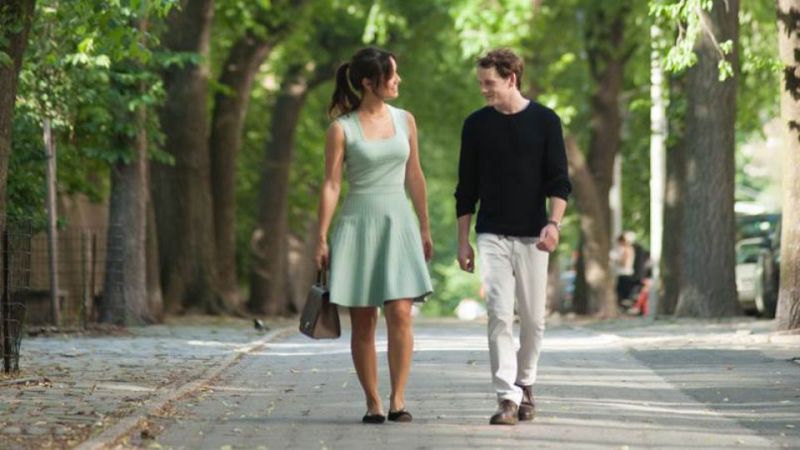While Agnès Varda’s 1962 film Cléo From 5 To 7 worked to subvert the longtime Gallic notion about 5 to 7 being the carefree hours one would spend in the arms of a paramour, a more conventional screenplay leaps forth off of Victor Levine’s 5 to 7, which delivers a sincere romance, garnished with its classic French flavors, on the urbane Big Apple platter. An honest attempt at capturing the sentimentalism of a bygone era, the film goes well beyond the stipulated definitions of the genre and defies neat categorization within its own borrowed structural framework by veering off to a predictable, albeit pregnant end. How? Let’s find out.
Image source: Youtube
An aspiring novelist Brian Bloom (Anton Yelchin) is disillusioned with life – his study wall festooned with rejection letters from publishers and the outcome of his struggle as elusive as the je ne sais quoi of any noble hero of the sentimental romance. And this is because an experiential palimpsest to feed the pages of his fiction arrives in the form of a beautiful French woman Arielle (Berenice Marlohe), whom he spies smoking on a NY sidewalk. A romantic rendezvous (if the wry in-French banter and a start with a ‘Little Mermaid’ reference cuts it) between the smitten scribbler and the smoky seductress begins the affair that frames the hours of the film’s title.
There is, however, just one hiccup – Arielle is married, to a French diplomat who, in turn, has a mistress of his own. Arielle explains this ‘open’ arrangement to Brian, who decides to flow with the tide, even after expressing his hesitation at accepting a proposition that affronts his sense of ethics. And why not? Because the beauty of a conversation that invigorates, a cultural exchange that exhilarates, and a passion that is all-consuming is undeniably powerful! It is only when Brian begins to chafe at being a ‘part’ of such a tiny window of her life that the movie’s denouement follows a hithertofore unanticipated trajectory. There is a remnant of the Joycean hero here, but the effect is as subtle in the actualization as the ‘reality’ of the romance in the fumant une cigarette. The choice, made next, is what makes ambling along the narrow in-ways of Central Park with Brian and Arielle worth the time you shall make for 5 to 7, hopefully between 5 and 7!
Suggested read: Why you should not miss even a sip of Margarita With A Straw
Now for the big question – if 5 to 7 is indeed what we just saw – a carafe of clichés – then, what really makes it an intoxicating watch? The answer, as I mentioned at the outset, lies in the defiance of the genre that Levine deploys in a beautiful and bold act of subverting and turning it on its head.
Image source: Youtube
In outlining the nuances involved within what makes a compelling study of human behavior, he gives us a taste of the Parisian hazy window of time wherein all accountability is suspended and a complete submission to the desires of the id is in play. But blatant questions about the situation peek out from behind the curtains. We are casting aside the central ethico-moral concern for a while – assuming that the cultural archetypes are enough to evince their existence and deployment. Even so, is adultery okay between two consenting adults who have kids? If yes, then does this open dynamic between the two justify the inclusion of a third person in the complicated equation, when clearly he/she could want more at a later stage? In bringing the need for an open dynamic in focus, the writer manages to spark off the discussion about how sterility and disillusionment in marriages can make covert or overt adultery unavoidable. In the face of a ‘marriage of convenience,’ is an open marriage an optimal answer? We don’t really get answers – and we don’t need to. It is in the direction of the contrived and obvious tragic end of the impossible love between the two that Levine steers our focus.
Apart from leaving a timeless message about love, its several manifestations, the inherent possibilities, the vacillation of those in-between the social definitions, and categories of ‘right’ and ‘wrong,’ and the pregnant engendering of a poignant discussion about the possibility of open relationships and the implications thereof in today’s time and age, the movie also transcends its sentimentalist mold, casts itself in a Kunstlerroman and depicts the coming of age of a sensitive youth lex externa – through an ineluctable condition of his own existence. It is in stringing together the several ambiguities, undertones, blatant messages, and symbols within the grand orchestral schema of 5 to7 that Levine makes his hero attain a coherent and integral interpretation of life. And we wait eagerly for the artist-martyr to conform to the mythic method of controlling, ordering, and shaping the significance of things through a heightened sense of expression found by wading through the panorama of futility, escape, collision, passion, and anarchy.
Image source: Youtube
However, it isn’t merely the injection of the French distaste for subscription to the dominant cultural script of monogamous behavior that is significant; it is the way the 5 to 7 leitmotif undercuts its own sweet current by injecting the lost love trope into the artistic-martyr category that the film hammers home its effect. Of course, one would do well to question the gender construct and ask why channeling the haunting memories of an impossible love affair into writing isn’t an available avenue to Arielle – but that is to steer the critical dialogue with the movie’s central concerns in a corner that isn’t really a part of the movie’s set pieces!! What really happens in the fine conflation of a somewhat prudish American leaning, relativistic French moral compass, and the sentimentalist genre is a powerful montage of an artist’s journey into self-actualization, the exploration of the everything that lies in between the dual ends of the monogamous and liberated spectrum of sexual and romantic behavior, and the inexplicably beautiful effect of a key relationship that can only be tasted and left behind – apropos, given that they aren’t to be ‘owned.’
Suggested read: 9 stunning scientific reasons why men cheat
As such, not only is the movie worth the hour and a half you’d spend to taste the 5 to 7 hours the lovers taste because of all it has to say about love, lost love, and the effect of having ‘loved and lost than to not have loved at all,’ but also because the inspired bit of casting with Frank Langella and Glenn Close as Brian’s Jewish parents who roll out quite a few amusing political zingers, a sexy seductress who makes the ‘amour’ credible, and our hero who does a Woody Allen-impression without being ludicrous are all a testament to the type of romanticism that lives on coz of Doctor Zhivago, Sleepless In Seattle, even Unfaithful or now, 5 to 7!!
Featured image source: Youtube












